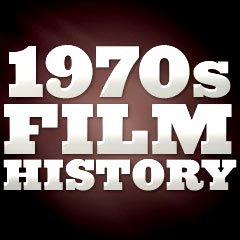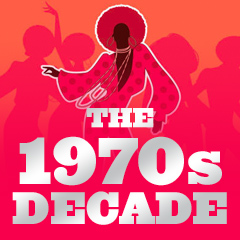 |
The 1970s The Last Golden Age of American Cinema (the American "New Wave") and the Advent of the Blockbuster Film Part 3 Film History of the 1970s Part 1, Part 2, Part 3, Part 4, Part 5, Part 6 Film History by Decade Index | Pre-1920s | 1920s | 1930s | 1940s | 1950s | 1960s 1970s | 1980s | 1990s | 2000s | 2010s |

|
|
All of Francis Ford Coppola's earlier 60s films were flops. He made his first film at UCLA (Tonight For Sure (1961)), served an apprenticeship with famed B-film director Roger Corman (e.g., The Terror (1963), Dementia 13 (1963), and Battle Beyond the Sun (1963)), made his commercial directorial debut with You're a Big Boy Now (1966), co-scripted Is Paris Burning? (1966), directed the entertaining, fanciful musical comedy Finian's Rainbow (1968) with Fred Astaire, and then from his own script directed his fourth feature film - the dramatic road film The Rain People (1969). In 1969, Coppola established his own production company, American Zoetrope - used for the production of co-founder George Lucas' THX 1138 (1971) and American Graffiti (1973). [Note: THX 1138 (1971) was a feature-length version of Lucas' earlier short-subject experimental film (titled Electronic Labyrinth: THX 1138 4EB) that he made as a student at USC in 1967. The short film provided him with a stepping stone to Warner Bros. as an intern working on Coppola's film The Rain People (1969).] In addition, Coppola's Oscar win as co-screenwriter for Patton (1970) gave him the break he needed for future, big-budgeted opportunities. The first big hit of the early 70s was Paramount's and Francis Ford Coppola's overpowering and absorbing, grand-scale gangster film - the Best Picture winner The Godfather (1972). The explicitly violent, complex, and majestic saga of the Brooklyn-located Corleone crime family that was based on Mario Puzo's pulpish best-seller presented so many memorable scenes and mythic overtones: the opening wedding sequence, the horse's head in a bed, the "I believe in America" speech, the Don's collapse in the garden, and Sonny's (James Caan) death at a tollbooth. This first film of the three-part epic became the first film to gross $100 million domestically, although its arrival was denounced by Italian-Americans protesting its violence and the association of the 'Mafia' with their ethnic group. Brando, who won his second Oscar, had shrewdly negotiated for only $100,000 and a percentage of the film. The influential film also brought Al Pacino to film stardom as boyish war hero and mob boss Michael - propelling the Lee Strasberg-trained actor from off-Broadway obscurity to prominence.
William Friedkin A former network television director, young film director William Friedkin found recognition for his early films The Night They Raided Minsky's (1968) and The Boys in the Band (1970). He then had two of the biggest hits of the early 70s - first, the hard-hitting, urban crime/cop thriller The French Connection (1971) - with Gene Hackman cast as a brutal and racist 'good' cop (Doyle) with cop-partner Russo (Roy Scheider) pursuing a ruthless but refined drug dealer (Fernando Rey). Friedkin's film featured a tense subway chase culminating in one of the most exciting, hair-raising 90 mph car chases ever filmed through busy New York streets.
Friedkin's unnerving film spawned two sequels and quickly encouraged an entire cycle of similar occult-horror films (with more sequels), such as:
Friedkin's over-budget suspense-thriller Sorcerer (1977) was a box-office failure. He ran into more difficulty during the filming of the controversial Cruising (1980), a film starring Al Pacino as a rookie undercover cop searching Manhattan's gay S&M underground to find a psychotic serial killer who preys on hardcore, leather-bar patrons. Outraged gay activist groups protested the depiction of homosexuals as sadomasochistic, sex-crazed, and demented.
An American Film Institute graduate, twenty-eight year old Terrence Malick scored his directorial / producer / writer debut with the moody, disturbing, nihilistic and lyrical drama Badlands (1973) about disenchanted youth, with teen-lovers on the run Martin Sheen and Sissy Spacek (who provided the narrative voice-over) in the lead roles. It was based upon the murder spree of late-50s real-life criminals Charles Starkweather and Caril Ann Fugate. Elements of the film have been widely copied since, e.g., True Romance (1993) and Natural Born Killers (1994). Five years later, Malick directed the beautifully-visualized, tragic love story Days of Heaven (1978) - and then didn't direct another film until two decades later - The Thin Red Line (1998). Michael Ritchie His best two satires were Smile (1975), a sardonic, humorous view of the callousness of a competitive Miss Teen USA beauty pageant with Annette O'Toole and Bruce Dern, and Semi-Tough (1977), a comedy about the hypocrisies of professional football and self-improvement fads. Ritchie's most popular film was The Bad News Bears (1976) about a rambunctious group of foul-mouthed Little Leaguers (The Bears) with star player Tatum O'Neal and their cigar-chomping, beer-guzzling coach (Walter Matthau). Paul Mazursky Michael Cimino Hal Ashby Ashby won an Oscar for Best Editing for In the Heat of the Night (1967) and then made his directorial debut with the social comedy The Landlord (1970), at the same time as the Kent State Massacre and the release of Altman's irreverent M*A*S*H (1970). It told the story of 29 year-old Elgar Enders (Beau Bridges) who left his privileged WASP home (and his ditzy mother played by Best Supporting Actress-nominated Lee Grant) and purchased a dilapidated tenement in a black ghetto in a changing, Brooklyn neighborhood and became its spoiled slum landlord, with many lessons to be learned. Ashby also opened the decade with the macabre and eccentric black comedy Harold and Maude (1971) about an inter-generational romance between a life-affirming septuagenarian survivor of the death camps (Ruth Gordon) and a suicidally-morbid, 20-something, suicide-obsessed young man (Bud Cort). Over the years, this odd and original film would acquire a huge audience of cultish admirers.
He also directed the adult bedroom comedy Shampoo (1975), a top hit of the mid-1970s co-produced and co-scripted by Robert Towne and Warren Beatty. It was significant for its time period surrounding Election Day in 1968 (the coming age of Nixon) when 60's idealism was rapidly vanishing. It starred Warren Beatty as George Roundy - a flirtatious, 34 year-old, long-haired Beverly Hills hairdresser. In the course of the film, George was a major seducer of women, including his ex-girlfriend Jackie (Julie Christie), Felicia (Lee Grant who won a Best Supporting Actress Oscar) - the wife of a prominent Republican politician and wealthy businessman named Lester Karp (Jack Warden), his own model-girlfriend Jill (Goldie Hawn), AND Felicia's teenaged daughter Lorna (a precocious Carrie Fisher pre-Star Wars! in her film debut). The frenetic world of the deceitful, hedonistic, dim-witted and narcissistic George eventually collapsed in on him - leaving him personally and financially bankrupt. By film's end, he inarticulately described what he had accomplished to Jill: "Let's face it, I f--ked 'em all. I mean, that's what I do. That's why I went to beauty school. I mean, they're always there and I-I just can't I-I, you know, I - I don't know what I'm apologizing for. So, sometimes I f--k 'em.... I don't know - I mean, that's it! It makes my day. I mean, it makes me feel like I'm gonna live forever." Ashby's Bound for Glory (1976) chronicled the life of folk singer Woody Guthrie. In the same year as Cimino's The Deer Hunter, Ashby directed the perceptive and melodramatic Coming Home (1978) about the problems of returning veterans (gung-ho husband Bruce Dern) and a woman torn between two men - it won the Best Actress (Jane Fonda as a volunteer in a veterans' hospital), Best Actor (Jon Voight as a paraplegic Vietnam vet), and Best Original Screenplay Oscar awards. Ashby's next film, the poetic Being There (1979), adapted from Jerzy Kosinski's novel and with Peter Sellers' last great film role as a simple-minded gardener ("I like to watch") named Chauncey Gardiner, satirized naivete and wisdom-as-innocence in the world of wealth and power politics. Steven Spielberg
George Lucas in the Early and Late 70s Born in Modesto, California in 1944, George Lucas got his start in film-making while attending USC, where in 1967 he famously created a short experimental sci-fi film that he eventually remade as THX 1138 (1971). After graduating, he co-founded American Zoetrope with UCLA grad Francis Ford Coppola. During an internship with Warner Bros., he was a production assistant for Coppola's Rain People (1969), and the Rolling Stones' documentary Gimme Shelter (1970). His next film project was the teenage-oriented film American Graffiti (1973) - produced through his own newly-formed LucasFilm and Universal. It was a nostalgic ensemble film that looked back fondly on his small-town California roots in Modesto, and concentrated on a subculture of teens. It was purposely set in 1962 before all the turmoil that came later in the decade (i.e., the assassinations of JFK, MLK Jr., and Robert Kennedy, the Vietnam War, the protests and counterculture, etc.). It was wildly popular with young audiences, featured a rock and pop-song soundtrack, car-racing (one of Lucas' early loves), and it launched the careers of many future stars, including Harrison Ford, Richard Dreyfuss, Ron Howard, Cindy Williams, and many others. After Star Wars, the first in a scheduled nine (now six) films in the entire epic, Lucas gave up the director's chair to executive-produce and script-write the first sequel The Empire Strikes Back (1980) by director Irvin Kershner, and to executive-produce and co-author the screenplay for the third in the trilogy, Return of the Jedi (1983) by director Richard Marquand. Through his company LucasFilm, Ltd., Lucas also executive-produced Steven Spielberg's "Indiana Jones" series of three adventure movies, beginning in 1981 and lasting through the end of the decade (with a fourth film added in 2008):
Part 1, Part 2, Part 3, Part 4, Part 5, Part 6 |